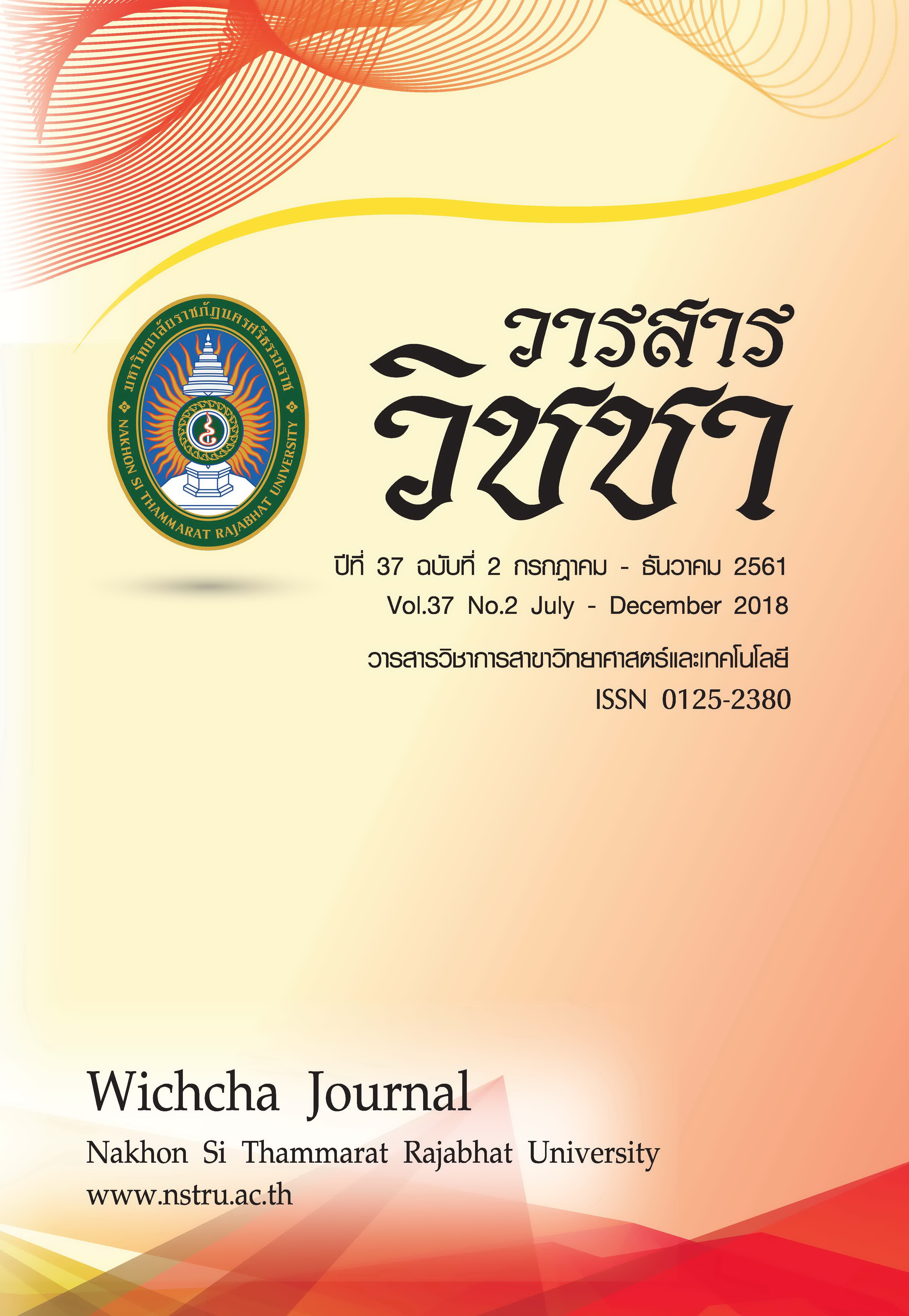Propagation of Moringa oleifera Lam. by Tissue Culture Technique
Main Article Content
Abstract
This present study was aimed to investigate micropropagation of Moringa oleifera Lam. by tissue culture technique. Zygotic embryos were cultured on MS, ½ MS and WPM medium. All culture media were added with 30 g/l sucrose and solidified with 8 g/l agar. The cultures were kept under the light condition at 3,000 lux, 16 h photoperiod and temperature at 25±2 °C. After culturing for 1 month, ½ MS medium was the best medium in terms of the highest survival rate at 93.33% followed by WPM and MS medium (80% and 76.67%, respectively). For plant growth and development, zygotic embryos cultured on MS medium gave the highest shoot induction (0.60±0.26%), number of shoot (0.97±0.69 shoots per piece) and root induction (63±0.09%). The half MS medium gave the highest height (3.65±1.09 cm), leaf length (0.14±0.05 cm) and root length (3.10±0.77 cm) of seedlings. WPM medium gave the highest number of leaf (3.03±0.55 leaves per piece) and number of roots (1.20±0.09 per explant). For callus induction, hypocotyl from two months old seedlings (0.5 cm in size) were cultured on MS medium supplemented with different concentrations of 2,4-D (0, 0.5, 1, 1.5, 2 and 2.5 mg/l) for 3 months. The results revealed that MS supplemented with 0.5 and 1 mg/l 2,4-D gave the highest percentage of callus induction (73 %). On the other hand, MS supplemented with 0.5 mg/l 2,4-D gave the highest fresh weight (258.88±15.11 mg) significant different with the other treatments (p≤ 0.05).
Article Details
เนื้อหาและข้อมูลในบทความที่ลงตีพิมพ์ในวารสารวิชชา มหาวิทยาลัยราชภัฏนครศรีธรรมราช ถือเป็นข้อคิดเห็นและความรับผิดชอบของผู้เขียนบทความโดยตรง ซึ่งกองบรรณาธิการวารสารไม่จำเป็นต้องเห็นด้วยหรือร่วมรับผิดชอบใด ๆ
บทความ ข้อมูล เนื้อหา รูปภาพ ฯลฯ ที่ได้รับการตีพิมพ์ในวารสารวิชชา มหาวิทยาลัยราชภัฏนครศรีธรรมราช ถือเป็นลิขสิทธ์ของวารสารวิชชา มหาวิทยาลัยราชภัฏนครศรีธรรมราช หากบุคคลหรือหน่วยงานใดต้องการนำข้อมูลทั้งหมดหรือส่วนหนึ่งส่วนใดไปเผยแพร่ต่อหรือเพื่อการกระทำการใด ๆ จะต้องได้รับอนุญาตเป็นลายลักษณ์อักษรจากวารสารวิชชา มหาวิทยาลัยราชภัฏนครศรีธรรมราชก่อนเท่านั้น
The content and information in the article published in Wichcha journal Nakhon Si Thammarat Rajabhat University, It is the opinion and responsibility of the author of the article. The editorial journals do not need to agree. Or share any responsibility.
References
มนฑล สงวนเสริมศรี นิภาพร พิมเสน พีรวุฒ วงศ์สวัสดิ์ และภพเก้า พุทธรักษ์. (2557) ผลของ NAA ร่วมกับ TDZ ต่อการชักนำให้เกิดแคลลัสในมะรุม (Moringa oleifera Lam). วารสารนเรศวรพะเยา, 7(3), 242-251.
มุกดา สุขสวัสดิ์. (2544). ความอุดมสมบูรณ์ของดิน. กรุงเทพฯ: โอเดียนสโตร์.
รัชนี เพ็ชร์ช้าง. (2554). การขยายพันธุ์ผักพื้นบ้านบางชนิดด้วยการเพาะเลี้ยงเนื้อเยื่อในตำบลนานกกก อำเภอลับแล จังหวัดอุตรดิตถิ์. วารสารมหาวิทยาลัยนเรศวร, 19(3), 35-42.
ลัดดาวรรณ อินทร์ดี (2557). การปลูกมะรุมและการแปรรูปมะรุม. สืบค้นเมื่อ 22 มิถุนายน 2561,
จาก: http://anusorn911.blogspot.com/2014/02/blog-post_8.html
สยามเฮิร์บ. (2557). มะรุม สรรพคุณทางยาประโยชน์และผลข้างเคียงจากงานวิจัย ม.มหิดล. สืบค้นเมื่อ 3 พฤศจิกายน 2560, จาก: http://siamherbs.blogspot.com/2014/09/moringa. html.
Bonga, J.M. and Aderkas, P.V. (1992). In Vitro Culture of Trees. Dordrecht: Kluwer Academic Publishers.
Farooq, S.A., Farooq, T.T. and Rao, T.V. (2002). Micropropagation of Annona squamosa L. using nodal explants. Pakistan Journal of Biological Science, 5, 43-46.
Katherine, K., Stephenson, S. and Fahey, J. W. (2004). Development of tissue culture method for the rescue and propagation of endangered Moringa Spp. Germplasm. Economic Botany, 58, S116-S124.
Oriabi, A. (2016). Moringa oleifera in vitro culture and its application as anti-diabetic in alloxan induced diabetic albino mice. International Journal of Current Microbiology and Applied Sciences, 5(2), 43-49.
Shittu, H.O., Aghogban, O.N., Akaluzia, H.C. and Chibuogwu, M.O. (2017). A comparison of callus production from Moringa oleifera Lam. leaf, cotyledon and stem explants using 2,4-Dichlorophenoxyacetic acid and kinetin for media supplementation. SAU Journal of science and technology, 2(1), 3-5.


